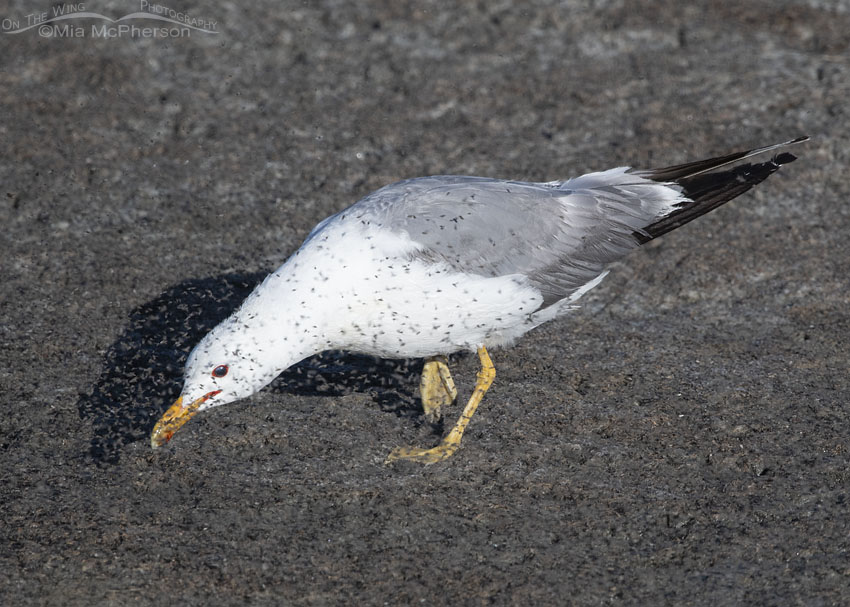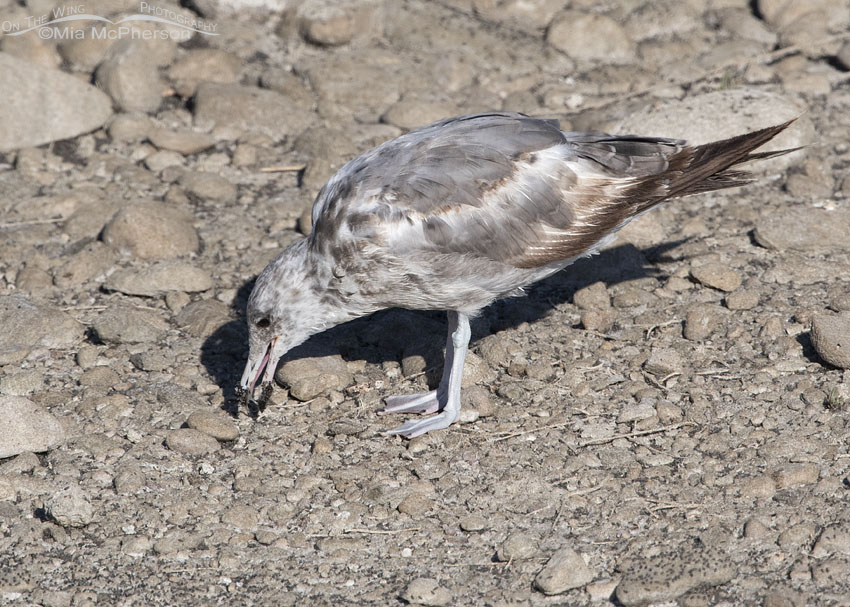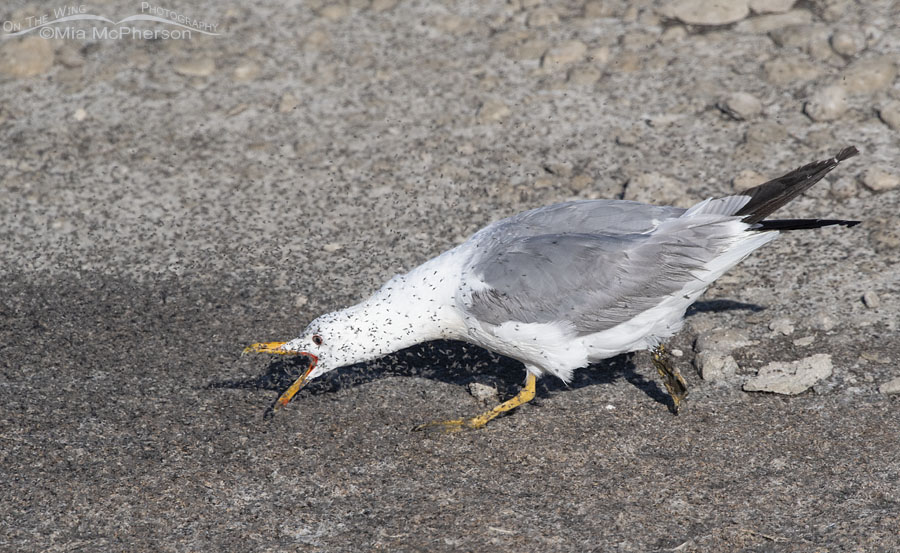I know that some people dislike gulls but I enjoy them, think they are beautiful and I find them to be interesting birds to observe and photograph. Brine flies that live in the Great Salt Lake are an important food source for California Gulls and watching the gulls feed on the flies is fascinating as they use several techniques to catch them.
There are two main species of brine flies that inhabit the hypersaline waters of the Great Salt Lake, Ephydra hians and Ephydra cinerea, of the two the Ephydra hians is the largest in size but only accounts for about 1% of the total population of brine flies that live in the Great Salt Lake area. Brine flies live most of their lives in the salty water as larvae who feed on cyanobacteria, other bacteria, diatoms, detritus and bottom-dwelling algae, after the larval stage of a brine fly’s life it develops a pupal case while it changes into an adult by a process called metamorphosis. They only live as winged flies for a few days and before the female flies die they lay their eggs in the lake.
 Adult California Gull scooping up brine flies with its bill – Nikon D500, f7.1, 1/2500, ISO 500, Nikkor 500mm VR with 1.4x TC, natural light
Adult California Gull scooping up brine flies with its bill – Nikon D500, f7.1, 1/2500, ISO 500, Nikkor 500mm VR with 1.4x TC, natural light
When the brine flies emerge from their pupal state they can be seen by the millions on the shoreline of the lake or as floating masses that form large mats on the water that move with the breeze. On the water gulls and other birds pick them off from the surface, on land California Gulls often use other techniques.
My personal favorite of the feeding techniques to observe and photograph is when the California Gulls chase after the brine flies and scoop them up with their bills because it is a challenge to get the gulls sharply in focus and because the flies move in a mass that resembles a crowd of people doing the “wave.”
Yesterday I was able to photograph this California Gull chasing the brine flies from the causeway to Antelope Island State Park and had fun while I was doing it.
 California Gull adult chasing a cloud a brine flies – Nikon D500, f7.1, 1/2500, ISO 500, Nikkor 500mm VR with 1.4x TC, natural light
California Gull adult chasing a cloud a brine flies – Nikon D500, f7.1, 1/2500, ISO 500, Nikkor 500mm VR with 1.4x TC, natural light
I have wondered quite often how many of the brine flies the gulls consume during their fast moving forays through the cloud of flies as it appears the gulls expend a lot of energy in the chase. It must work for them or they wouldn’t do it.
The gulls chase the flies in one direction then when they stop they seem to wait a few seconds, turn around then chase the flies in the opposite direction.
 Immature California Gull eating brine flies one by one – Nikon D500, f7.1, 1/2500, ISO 500, Nikkor 500mm VR with 1.4x TC, natural light
Immature California Gull eating brine flies one by one – Nikon D500, f7.1, 1/2500, ISO 500, Nikkor 500mm VR with 1.4x TC, natural light
I also watched an immature California Gull pick flies off the ground one by one, maybe it is so young it hasn’t learned how to chase after the flies like older gulls do or perhaps this young gull was just being a bit lazier as it fed on the brine flies.
 Adult California Gull chasing brine flies at the Great Salt Lake – Nikon D500, f7.1, 1/2500, ISO 500, Nikkor 500mm VR with 1.4x TC, natural light
Adult California Gull chasing brine flies at the Great Salt Lake – Nikon D500, f7.1, 1/2500, ISO 500, Nikkor 500mm VR with 1.4x TC, natural light
I’m always happy to photograph California Gulls chasing after brine flies on the shoreline of the Great Salt Lake.
As the Great Salt Lake dries up; which it has been doing for several years, the water is becoming more saline and the time might come when it is too saline to support the life cycle of the brine flies that live in it. Brine flies are an important food source for our resident and migratory birds and I believe it is critical that we take action to ensure that the lake has enough water to support them. Trying to convince our government representatives of the need to take action has been problematic in this state, they had better wake up soon.
Life is good.
Mia
Click here to see more of my California Gull photos plus facts and information about this species. Click here to see more of my Brine Fly photos.


Thank you for the beautiful shots. I much prefer to visit Antelope Island thru your lens as the last time my husband and I were there we were nearly eaten alive by the migies. The buffalo had sought refuge nearly a mile out from the shore line in order to escape the little buggers. The detail in your photos are so visually exciting. The colors are beautiful.
Thank you for sharing your beautiful work.
You are appreciated and loved!!!
A brine fly buffet!
There are so many of the suckers that it looks as if the gull only needs to stand still with its mouth open!
Wow.
A tornado of Brine flies!!!! Glad they are useful for something….